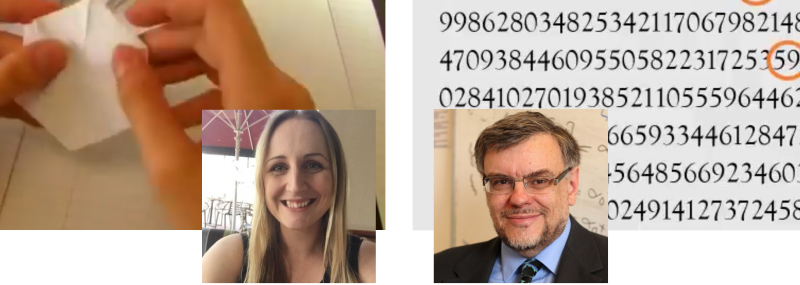
Here’s the final match in Round 1 of The Big Internet Math-Off. Our last two competitors are Jo Morgan and Tony Mann.
Take a look at both pitches, vote for the bit of maths that made you do the loudest “Aha!”, and if you know any more cool facts about either of the topics presented here, please write a comment below!
Jo Morgan – Hexaflexagons
 Jo Morgan is a maths teacher, and owner of the resource site resourceaholic.com. You can find her on Twitter at @mathsjem.
Jo Morgan is a maths teacher, and owner of the resource site resourceaholic.com. You can find her on Twitter at @mathsjem.
At first glance, the humble hexaflexagon appears to be little more than a colourful fidget toy for bored mathematicians. But look a little closer and you’ll see that hexaflexagons are both fascinating and delightful, and I’m here to tell you why I love them.
I’m rubbish at origami. Dexterity and precision are not my strengths. But making hexaflexagons is different. Anyone can do it. At first I struggled to get the hang of the flexing, but after a bit of practice I was off… flexing here, flexing there, flexing everywhere. It’s addictive. And now I can’t get enough of hexaflexagons. They’re flat but they have three faces! Mathematical wonder at its best.
A flexagon is made by folding a strip of paper into adjacent equilateral triangles. Each one of the triangular regions is called a pat. Unlike most forms of mathematical paper folding, it’s not so much the geometry that’s the interesting bit – it’s the combinatorics. A flexagon is kind of like a cross between a Rubik’s cube and a Möbius strip.
The story of flexagons is littered with mathematical name drops. They were first discovered in 1939 by British topologist Arthur Stone. If Brits and Americans used the same size paper then they would never have existed. The Princeton Flexagon Committee was set up to investigate their properties and included mathematicians Bryant Tuckerman, Richard Feynman and John Tukey (incidentally, Tukey is famous amongst secondary school teachers for inventing the Stem and Leaf Plot – the Marmite of school level statistics). Flexagons were popularised by Martin Gardner in 1956 but are still relatively unknown. Why on earth do school children play with those dull fortune tellers in the playground when they could be impressing their friends with an awesome hexaflexagon?
Watch Vi Hart’s series of videos on Hexaflexagons. I am certain that you’ll fall in love with them.
 Tony Mann – The secrets of the universe in random numbers
Tony Mann – The secrets of the universe in random numbers
Tony Mann is a lecturer at the University of Greenwich and maths outreach expert. You can find him on Twitter at @tony_mann.
Tony has made a short video about how to score 100% on any exam.
So, which bit of maths has tickled your fancy the most? Vote now!
Round 1 match 8 - Morgan v Mann
- Jo Morgan with hexaflexagons
- (62%, 214 Votes)
- Tony Mann with random numbers
- (38%, 132 Votes)
Total Voters: 346
This poll is closed.
The poll closes at 9am BST on the 10th. Whoever wins the most votes will get the chance to tell us about more fun maths in round 2.
Come back on the 11th for our first match in round 2, pitting Nira Chamberlain against Alison Kiddle, or check out the announcement post for your follow-along wall chart!
I found this article very interesting. Never knew about those hexaflexagons.
I need to learn how to write mathematics that can appear on web pages the same way it looks on my computer screen when I use math type. I end up posting my notes using scribbd. Could you please point me in a direction that can help me learn?
Hi Garfield,
I don’t know about MathType, but on the blog here we have configured MathJax: https://www.mathjax.org
Based on a quick Google, this page says MathType can output webpages that can be viewed using MathJax: http://dessci.com/en/support/mathtype/tsn/tsn165.htm
Hope that helps!
Peter.